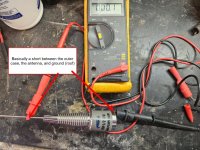Kzneft
Newbie
I really can't get an answer to my question from Rugged Radio so I will post it here as I am sure there are lots of smarter people here then me when it comes to antenna's...
Have a Rugged radio in my SxS and get almost no distance when transmitting (Like 100 feet). I checked my cable from my Rugged Radio to my antenna, and it looked like it got very hot and noticed some melted shielding. I know I need to replace the cable, but I thought maybe I would check the antenna to see if there was a short or something that might have caused the cable to get hot in the first place. I put my continuity tester between the antenna and my frame (ground) (see pic), and yes there was a connection. I thought that was odd. I then checked the connection between the antenna and the center of the connector that is supposed to connect to the center wire on the coaxial cable, and it was an open circuit. Isn't there suppose to be continuity between the center pin and the actual antenna, but no connection between the antenna and ground?


Have a Rugged radio in my SxS and get almost no distance when transmitting (Like 100 feet). I checked my cable from my Rugged Radio to my antenna, and it looked like it got very hot and noticed some melted shielding. I know I need to replace the cable, but I thought maybe I would check the antenna to see if there was a short or something that might have caused the cable to get hot in the first place. I put my continuity tester between the antenna and my frame (ground) (see pic), and yes there was a connection. I thought that was odd. I then checked the connection between the antenna and the center of the connector that is supposed to connect to the center wire on the coaxial cable, and it was an open circuit. Isn't there suppose to be continuity between the center pin and the actual antenna, but no connection between the antenna and ground?



